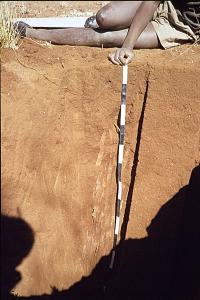Reference soil Namibia 05: Lixisol
Lixisols occur dominantly in the drier parts of the tropics and subtropics. Their high base status is partly due to less leaching, partly to admixture from airborne dust from adjacent desert regions.
Characteristics
Soils having an argic horizon (a subsurface horizon with a distinct higher clay content than the overlying horizon), which has a cation exchange capacity of less than 24 cmolc per kg in some part, either starting within either: 100 cm from the soil surface, or 200 cm from the soil surface if the argic horizon is overlain by loamy sand or coarser textures throughout. They have a base saturation (total amount of Ca, Mg, K and Na with respect to the cation exchange capacity) of 50 percent or more in the major part between 25 and 100 cm from the soil surface.
Reference soil NA005: Lixisols
Lixisol. Top 1/2 cm consists of wind-blown sand
